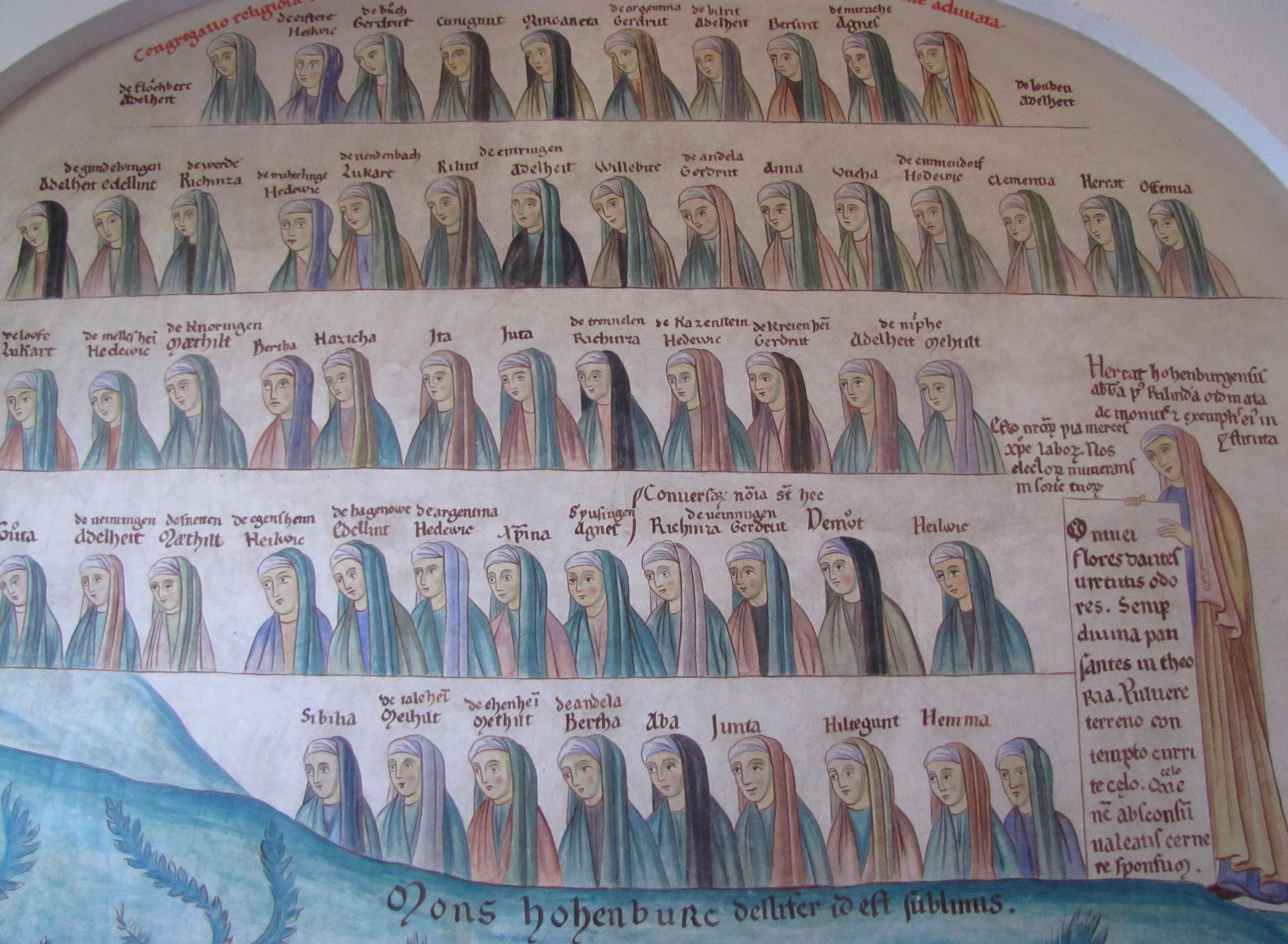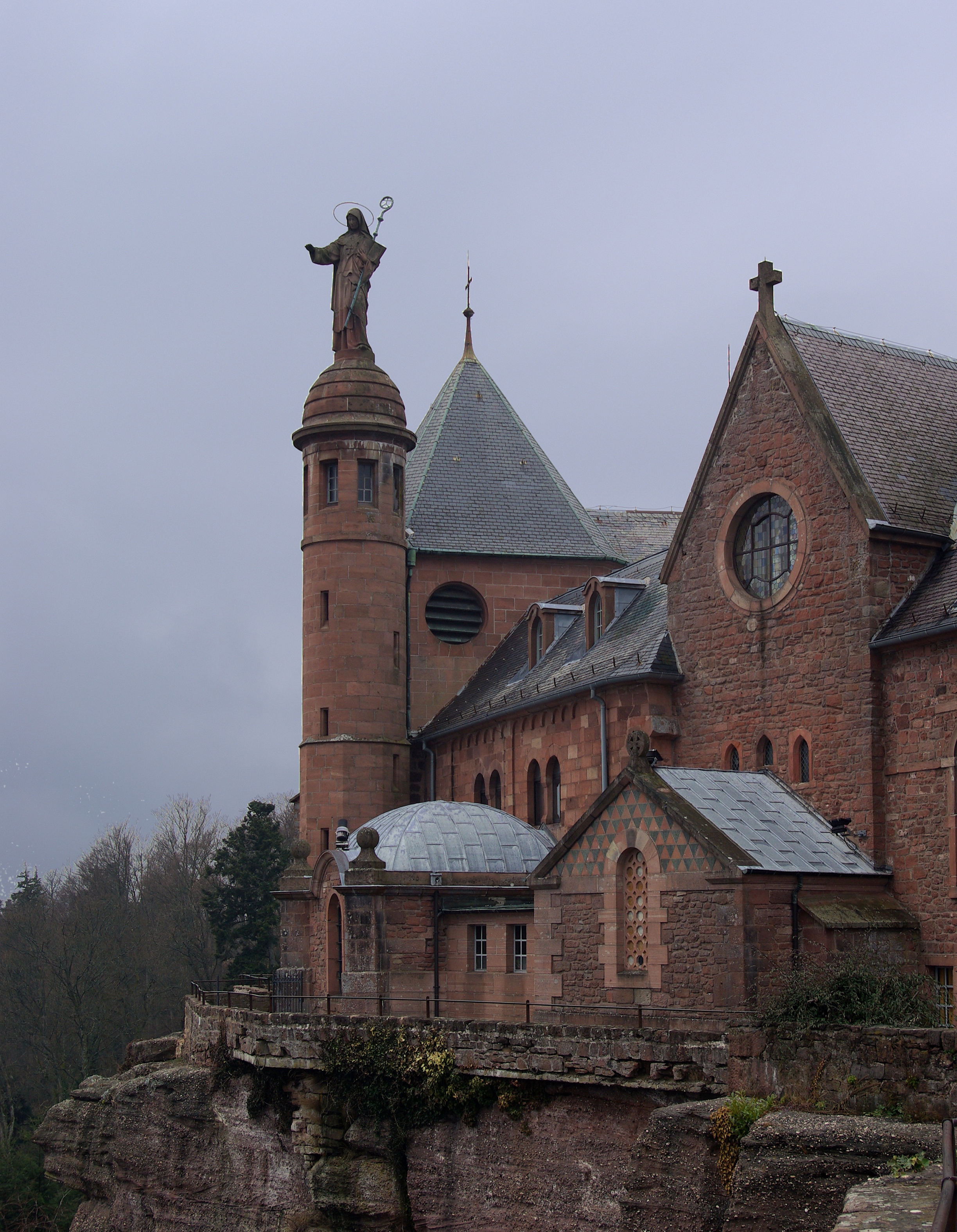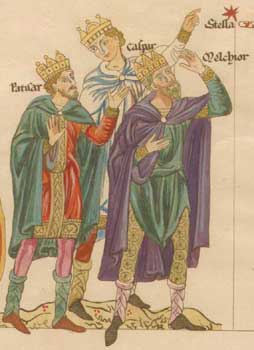Herrad Of Landsberg on:
[Wikipedia]
[Google]
[Amazon]
Herrad of Landsberg ( la, Herrada Landsbergensis; 1130 – July 25, 1195) was a 12th-century Alsatian nun and abbess of Hohenburg Abbey in the
 Born about 1130 at the castle of Landsberg, the seat of a noble Alsatian family, she entered Hohenburg Abbey in the Vosges mountains, about fifteen miles from
Born about 1130 at the castle of Landsberg, the seat of a noble Alsatian family, she entered Hohenburg Abbey in the Vosges mountains, about fifteen miles from

 As early as 1159 Herrad had begun within the cloister walls the work for which she is best known, the ''Hortus deliciarum'', a compendium of all the sciences studied at that time. It was written for the women in Herrad's convent, in order to further the teaching of biblical, moral, and theological material, and was completed in 1185. In it, Herrad delves into the battle of Virtue and Vice with vivid visual imagery preceding the text.
The original manuscript consisted of 648 pages on 324 parchment sheets. The majority of the work is written in Latin, with approximately 1250 glosses in German. The work shows a wide range of reading. Its chief claim to distinction is the 336 illustrations which adorn the text. Many of these are symbolical representations of theological, philosophical, and literary themes; some are historical, some represent scenes from the actual experience of the artist, and one is a collection of portraits of her sisters in religion. The technique has been very much admired and in almost every instance they show an artistic imagination which is rare in Herrad's contemporaries.
While other artists and writers contributed to the ''Hortus deliciarum'', it was largely compiled, written, and edited by Herrad. Many of the poems and hymns were written by Herrad, and it is speculated that much of the art was created under the direction of Herrad as well.
After having been preserved for centuries at Hohenburg Abbey, the manuscript of ''Hortus deliciarum'' passed into the municipal library of Strasbourg about the time of the
As early as 1159 Herrad had begun within the cloister walls the work for which she is best known, the ''Hortus deliciarum'', a compendium of all the sciences studied at that time. It was written for the women in Herrad's convent, in order to further the teaching of biblical, moral, and theological material, and was completed in 1185. In it, Herrad delves into the battle of Virtue and Vice with vivid visual imagery preceding the text.
The original manuscript consisted of 648 pages on 324 parchment sheets. The majority of the work is written in Latin, with approximately 1250 glosses in German. The work shows a wide range of reading. Its chief claim to distinction is the 336 illustrations which adorn the text. Many of these are symbolical representations of theological, philosophical, and literary themes; some are historical, some represent scenes from the actual experience of the artist, and one is a collection of portraits of her sisters in religion. The technique has been very much admired and in almost every instance they show an artistic imagination which is rare in Herrad's contemporaries.
While other artists and writers contributed to the ''Hortus deliciarum'', it was largely compiled, written, and edited by Herrad. Many of the poems and hymns were written by Herrad, and it is speculated that much of the art was created under the direction of Herrad as well.
After having been preserved for centuries at Hohenburg Abbey, the manuscript of ''Hortus deliciarum'' passed into the municipal library of Strasbourg about the time of the Creation of the BNU
bnu.fr during the
Hortus Deliciarum
iath.virginia.edu
Illustrations from the Hortus Deliciarum by Chr. M. Engelhardt
digi.ub.uni-heidelberg.de
oberlin.edu
Illustrations from Engelhardt's description of the Hortus Deliciarum from 1818.
digi.ub.uni-heidelberg.de {{ACArt 1195 deaths 12th-century births 12th-century French women writers 12th-century Latin writers 12th-century philosophers 12th-century French scientists French Roman Catholic abbesses French nobility French women artists French women philosophers French women scientists Manuscript illuminators Medieval women scientists People from Bas-Rhin 12th-century French nuns Romanesque artists Women religious writers Women science writers
Vosges mountains
The Vosges ( , ; german: Vogesen ; Franconian and gsw, Vogese) are a range of low mountains in Eastern France, near its border with Germany. Together with the Palatine Forest to the north on the German side of the border, they form a single ...
. She was known as the author of the pictorial encyclopedia ''Hortus deliciarum
__NOTOC__
The ''Hortus deliciarum'' (Latin for ''Garden of Delights'') was a medieval manuscript compiled by Herrad of Landsberg at the Hohenburg Abbey in Alsace, better known today as Mont Sainte-Odile.
Description
The ''Hortus deliciarum'' ...
'' (''The Garden of Delights'').
Life at the Abbey
Strasbourg
Strasbourg (, , ; german: Straßburg ; gsw, label= Bas Rhin Alsatian, Strossburi , gsw, label=Haut Rhin Alsatian, Strossburig ) is the prefecture and largest city of the Grand Est region of eastern France and the official seat of the Eu ...
, at an early age. Hohenburg Abbey, also known as Mont St Odile, was run by Abbess Relinda, a nun sent from the Benedictine
, image = Medalla San Benito.PNG
, caption = Design on the obverse side of the Saint Benedict Medal
, abbreviation = OSB
, formation =
, motto = (English: 'Pray and Work')
, found ...
monastery of Bergen
Bergen (), historically Bjørgvin, is a city and municipality in Vestland county on the west coast of Norway. , its population is roughly 285,900. Bergen is the second-largest city in Norway. The municipality covers and is on the peninsula ...
in Bavaria. Due to her support from the Holy Roman Emperor
The Holy Roman Emperor, originally and officially the Emperor of the Romans ( la, Imperator Romanorum, german: Kaiser der Römer) during the Middle Ages, and also known as the Roman-German Emperor since the early modern period ( la, Imperator ...
Frederick Barbarossa
Frederick Barbarossa (December 1122 – 10 June 1190), also known as Frederick I (german: link=no, Friedrich I, it, Federico I), was the Holy Roman Emperor from 1155 until his death 35 years later. He was elected King of Germany in Frankfurt on ...
the abbey was extremely successful and powerful, as well as a source for reform. At the abbey Herrad received the most comprehensive education available to women during the 12th century. As she grew older she rose to a high position in office at the abbey, and was soon put in charge of governing and educating her fellow nuns. After Relinda's death, Herrad was elected abbess in 1167.
As abbess, Herrad worked on rebuilding the monastery, as well as consolidating the land surrounding the monastery under its ownership. She proved herself to be a capable and well-loved abbess, and it was at this time that she began her work on the ''Hortus Deliciarum''. Herrad was abbess for 28 years, and continued in that office until her death in 1195. Adelhaid of Faimingen was her successor.
''Hortus deliciarum''
 As early as 1159 Herrad had begun within the cloister walls the work for which she is best known, the ''Hortus deliciarum'', a compendium of all the sciences studied at that time. It was written for the women in Herrad's convent, in order to further the teaching of biblical, moral, and theological material, and was completed in 1185. In it, Herrad delves into the battle of Virtue and Vice with vivid visual imagery preceding the text.
The original manuscript consisted of 648 pages on 324 parchment sheets. The majority of the work is written in Latin, with approximately 1250 glosses in German. The work shows a wide range of reading. Its chief claim to distinction is the 336 illustrations which adorn the text. Many of these are symbolical representations of theological, philosophical, and literary themes; some are historical, some represent scenes from the actual experience of the artist, and one is a collection of portraits of her sisters in religion. The technique has been very much admired and in almost every instance they show an artistic imagination which is rare in Herrad's contemporaries.
While other artists and writers contributed to the ''Hortus deliciarum'', it was largely compiled, written, and edited by Herrad. Many of the poems and hymns were written by Herrad, and it is speculated that much of the art was created under the direction of Herrad as well.
After having been preserved for centuries at Hohenburg Abbey, the manuscript of ''Hortus deliciarum'' passed into the municipal library of Strasbourg about the time of the
As early as 1159 Herrad had begun within the cloister walls the work for which she is best known, the ''Hortus deliciarum'', a compendium of all the sciences studied at that time. It was written for the women in Herrad's convent, in order to further the teaching of biblical, moral, and theological material, and was completed in 1185. In it, Herrad delves into the battle of Virtue and Vice with vivid visual imagery preceding the text.
The original manuscript consisted of 648 pages on 324 parchment sheets. The majority of the work is written in Latin, with approximately 1250 glosses in German. The work shows a wide range of reading. Its chief claim to distinction is the 336 illustrations which adorn the text. Many of these are symbolical representations of theological, philosophical, and literary themes; some are historical, some represent scenes from the actual experience of the artist, and one is a collection of portraits of her sisters in religion. The technique has been very much admired and in almost every instance they show an artistic imagination which is rare in Herrad's contemporaries.
While other artists and writers contributed to the ''Hortus deliciarum'', it was largely compiled, written, and edited by Herrad. Many of the poems and hymns were written by Herrad, and it is speculated that much of the art was created under the direction of Herrad as well.
After having been preserved for centuries at Hohenburg Abbey, the manuscript of ''Hortus deliciarum'' passed into the municipal library of Strasbourg about the time of the French Revolution
The French Revolution ( ) was a period of radical political and societal change in France that began with the Estates General of 1789 and ended with the formation of the French Consulate in November 1799. Many of its ideas are consider ...
. There the miniatures were copied by Christian Moritz Engelhardt and published by Cotta in Stuttgart in 1818. The text was copied and published by Straub and Keller between 1879 and 1899 including some coloured copies from Herrad's illustrations made by Wilhelm Stengel. Thus, although the original perished in the burning of the libraries of the Protestant seminary and the city of Strasbourgbnu.fr during the
Siege of Strasbourg
The siege of Strasbourg took place during the Franco-Prussian War, and resulted in the French surrender of the fortress on 28 September 1870.
After the German victory at Wörth, troops from the Grand Duchy of Baden under Prussian General A ...
in 1870 in the Franco-Prussian War, we can still form an estimate of the artistic and literary value of Herrad's work.
See also
*Women artists
The absence of women from the canon of Western art has been a subject of inquiry and reconsideration since the early 1970s. Linda Nochlin's influential 1971 essay, " Why Have There Been No Great Women Artists?" examined the social and institu ...
*Hildegard von Bingen
Hildegard of Bingen (german: Hildegard von Bingen; la, Hildegardis Bingensis; 17 September 1179), also known as Saint Hildegard and the Sibyl of the Rhine, was a German Benedictine abbess and polymath active as a writer, composer, philosop ...
* Hrotsvitha of Gandersheim
References
Notes
Citations
Sources
* * * * * * * *Further reading
* Chadwick, Whitney, ''Women, Art, and Society,'' Thames and Hudson, London, 1990 *Dionysius Albrecht. ''History von Hohenburg oder St. Odilien-Berg.'', Schlettstatt 1751. * Harris, Anne Sutherland andLinda Nochlin
Linda Nochlin (''née'' Weinberg; January 30, 1931 – October 29, 2017) was an American art historian, Lila Acheson Wallace Professor Emerita of Modern Art at New York University Institute of Fine Arts, and writer. As a prominent feminist art hi ...
, ''Women Artists: 1550-1950'', Los Angeles County Museum of Art, Knopf, New York, 1976
*Heinrich Reumont. ''Die Deutschen Glossen Im Hortus Deliciarum Der Herrad Von Landsberg.'' W. Reumont, Metz 1900.
* A. Straub, G. Keller. ''Hortus deliciarum = Garden of delights.'' New Rochelle, N.Y.: Caratzas Bros., 1977.
External links
Hortus Deliciarum
iath.virginia.edu
Illustrations from the Hortus Deliciarum by Chr. M. Engelhardt
digi.ub.uni-heidelberg.de
oberlin.edu
Illustrations from Engelhardt's description of the Hortus Deliciarum from 1818.
digi.ub.uni-heidelberg.de {{ACArt 1195 deaths 12th-century births 12th-century French women writers 12th-century Latin writers 12th-century philosophers 12th-century French scientists French Roman Catholic abbesses French nobility French women artists French women philosophers French women scientists Manuscript illuminators Medieval women scientists People from Bas-Rhin 12th-century French nuns Romanesque artists Women religious writers Women science writers